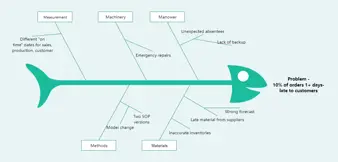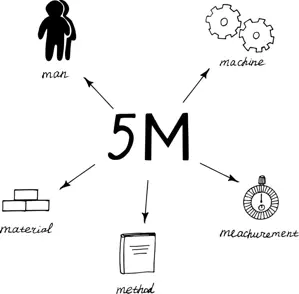What is the 5M Model? The Importance of the 5M Governance Model
In the world of business and manufacturing, efficiency and quality are paramount. To achieve these goals, organizations employ various management models and frameworks. One such model that has gained prominence is the 5M Model. In this blog, Aniday will explore what is 5M Model, its meaning, significance, and its role in governing processes.

1. What is the 5M Model?
The 5M Model is a governance model widely used in business and manufacturing to enhance the efficiency and quality of processes. This model focuses on five key elements, each of which plays a vital role in the overall success of any operation. The 5M Model elements are: Manpower - Measurement - Machinery and Equipment - Materials - Method.
2. Meaning of the Elements in the 5M Governance Model

2.1. Manpower
Manpower, the first 'M' in the model, represents the human resources involved in a process. Skilled and knowledgeable personnel are essential for operating machinery, handling materials, and following methods effectively. The success of any business or manufacturing operation heavily depends on the competence and dedication of the workforce.
2.2. Measurement
Measurement, the second 'M,' underscores the importance of quality control and assurance. It involves assessing the output at various stages to ensure that the product meets the desired specifications and standards. Effective measurement not only helps in detecting defects early but also provides data for process improvement.
2.3. Machinery and Equipment
'Machinery and Equipment' emphasize the third 'M' in the model. To produce products efficiently and consistently, it's crucial to have the right tools and machinery in place. The choice of equipment, its maintenance, and its compatibility with the production process are vital aspects of this element.
2.4. Materials
The 'Materials' element, often the heart of manufacturing, represents the raw materials and components used in the production process. Ensuring that the right materials are available, that they meet quality standards, and are used efficiently is fundamental for minimizing waste and optimizing the process.
2.5. Implementation Method
The 'Implementation Method' is the final 'M' in the 5M Model. This element addresses the processes and procedures used to create the product. It involves well-defined step-by-step instructions, workflows, and standard operating procedures to ensure consistent and high-quality results.
3. The Role of the 5M Model
The 5M Model is a governance framework that plays a pivotal role in driving efficiency, maintaining quality, and fostering continuous improvement within various organizations, particularly in the realms of manufacturing, production, and service delivery. This section will delve deeper into the specific roles and functions the 5M Model fulfills in the context of business management and why it's essential for achieving operational excellence.

3.1. Enhancing Efficiency
The 5M Model's main function is to increase operational efficiency in businesses. The five components—manpower, measurement, machinery and equipment, materials, and implementation method—are each carefully evaluated in order to achieve this. Organizations can streamline their operations, cut waste, and make sure resources are used as effectively as possible by maximizing these factors. Costs are reduced as a result, and production is increased along with turnaround times.
3.2. Ensuring Quality Assurance
Quality assurance is a critical function of the 5M Model. Through its emphasis on Measurement and Materials, the model ensures that the quality of products and services is consistently maintained. By measuring the output at various stages and by carefully managing the materials used in production, organizations can prevent defects and errors from propagating through the process. This not only enhances customer satisfaction but also reduces rework and associated costs.
3.3. Standardization and Consistency
Standardization is another vital role played by the 5M Model. By clearly defining Implementation Methods and establishing Standard Operating Procedures (SOPs), organizations can standardize their processes. This makes it easier to train employees and maintain a high level of consistency in product or service output. Standardization is particularly crucial for businesses that seek to scale their operations while maintaining quality.
3.4. Promoting a Culture of Continuous Improvement
The 5M Model is not a static framework; it's designed to promote a culture of continuous improvement. By regularly measuring and evaluating processes, organizations can identify areas for enhancement and take proactive steps to make necessary changes. This fosters an environment where employees are encouraged to propose improvements and innovations, ultimately leading to an ongoing cycle of refinement and optimization.
3.5. Supporting Decision-Making
In the fast-paced world of business, data-driven decision-making is crucial. The Measurement aspect of the 5M Model provides organizations with valuable data to support informed decisions. By regularly monitoring key performance indicators (KPIs) related to manpower, machinery, materials, and methods, decision-makers can identify trends, pinpoint areas of concern, and make strategic choices that drive the business forward.
3.6. Facilitating Compliance and Risk Management
Compliance with industry norms and regulations is crucial for organizations working in regulated sectors. The 5M Model encourages compliance by ensuring that the procedures and materials utilized comply with pertinent industry standards and that the materials used meet regulatory criteria. The methodology additionally aids in reducing risks related to non-compliance by encouraging constant quality control.
3.7. Creating a Competitive Advantage
In a competitive market, organizations that can deliver high-quality products or services efficiently gain a significant advantage. The 5M Model equips businesses with the tools they need to excel in this regard. By optimizing resources, maintaining quality, and promoting continuous improvement, organizations can distinguish themselves in the marketplace, attracting and retaining customers.
3.8. Achieving Sustainable Growth
Sustainable growth is a goal for most businesses. The 5M Model, by promoting efficiency and quality, supports sustainable growth. It allows organizations to increase their capacity and expand their offerings without sacrificing quality. Sustainable growth, in turn, can lead to increased revenue, profitability, and long-term success.
4. Factors Affecting the 5M Leadership Model
The effectiveness of the 5M Leadership Model can be influenced by various factors, including:
-
Industry: Different industries may have unique requirements and challenges. The applicability of the 5M Model may vary based on the nature of the industry.
-
Company Culture: An organization's culture and values play a significant role in how the 5M Model is implemented. A culture that values continuous improvement is likely to benefit more from this model.
-
Technological Advancements: Technological advancements can affect the machinery and equipment aspect of the 5M Model. Businesses that stay current with technology are better equipped to leverage this model.
-
Regulatory Environment: Regulatory requirements can impact the choice of materials and methods. Compliance with regulations is essential for industries with strict standards.
In conclusion, the 5M Model, with its focus on manpower, measurement, machinery and equipment, materials, and implementation methods, plays a crucial role in improving efficiency and product quality in various industries. Factors such as industry, company culture, technological advancements, and regulatory requirements can influence the model's effectiveness.
The article has shown that it explores "What is 5M model" and how businesses use it to enhance processes, optimize resource utilization, and provide high-quality products and services. As businesses continue to strive for excellence in their processes, the 5M Model remains a valuable tool in their arsenal. Aniday believes that its comprehensive approach to management is evidence of its long-term significance in the ever-evolving world of business and manufacturing.
Aniday's HR Services
Headhunting Service
Find and recruit quality candidates in just 1 week! Supported by 40,000 experienced headhunters in IT, Finance, Marketing… capable of recruiting in any region.
Headhunting Service ➔Employer of Record (EOR) Service
On behalf of your business, we recruit employees and handle payroll without the need to establish a company in markets such as Vietnam, Singapore, Malaysia, India, Indonesia…
Employer of Record (EOR) Service ➔